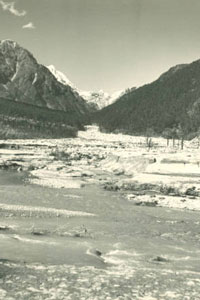1952 Sikkim/Nepal Expedition Video
After the disappointment of the earlier 1949 expedition due to altitude sickness, my father was determined to return to same area of the 1949 expedition that he visited with Trevor Braham. He also wanted to visit a few new areas in the region. This time he travelled on his own and would not have the services of an elite sherpa leader like Ang Tharkay but another competent sherpa leader – recommended by Ang Tharkay – called Sonam.
The objective of the 1952 expedition was to trek into the eastern part of Sikkim, following some of the same initial route of the 1949 expedition. This time, however, he assembled an expedition team of six sherpas and two sherpanis (female sherpas). My father was full of praise of the two sherpanis and noted that they more than held their own, carried the same loads, had some added skills and most of all “..did not complain…” when compared to their male counterparts. In Gangtok, Sonam finalised all their provisioning needs and hired mountain ponies to carry their provisions and tents part of the way to Singhik, where they parted with the pony escort.
Their route retraced some familiar ground: following the Teesta River to Dikchu, onto to Mangan and Singhik. From Singhik they trekked to Changtang via Tong. At Changtang, the rivers Lachen Chu (river) and Lachung Chu converge. They took the right fork in the river towards Kedom and Lachung, finally arriving in Lachung five days later. Here they overnighted at the chowkidar’s Dak bungalow.

Approaching Yumthang from Lachung
From Lachung they trekked along the Lachung Chu in a beautiful valley to Yumathang and then on to Mome Samdong. On August 15th, 1950 there had occured the great Tibet – Assam earthquake which seriously affected this region. The Sebu Cho (lake) on the lower portion of Chombu mountain 6363m is fed by the icefall. During the earthquake, a large portion of this icefall is believed to have collapsed, sending large chunks of the mountain and ice into the Sebo Cho causing the lake to burst. The released waters from the lake swept everything before it because of the power of the tidal wave and and this caused severe damage down the valley, in the process destroying half of Lachung village and sweeping away many suspension bridges that crossed the Lachung Chu. The route from Lachung to Mome Samdong was now mainly over boulders and moraine debris. They camped near Mome Sandong at a site with a few scattered small lakes and scrub and used the juniper wood in the area for cooking and to provide warmth.
At Mome Samdong they had great views of many Himalayan peaks, including the south face of Mt. Chombu. From Mome Sandong they climbed to the Sebu La pass 5352m where they had a close-up view of Mt. Kanchenjau 6919m. An attempt to climb Mt. Kanchenjau failed as the conditions underfoot were deemed to be dangerous. After crossing the Sebu La pass they established a camp on the western side of the pass where they got a splendid view of numerous peaks and also Mt. Kangchenjunga 8585m.
From here they made their way into the Lhonak Valley via the Lugnak La pass 5035m to Muguthang and Dolimasampa. They then trekked into the Langpo Chu valley and set up a camp in the close vicinity of Langpo Peak 7462m.
The expedition then moved into the Jongsong Glacier and the Langchung Khang Glacier area and camped at the Jongsong La pass at 6145m. They then continued down into the valley to the western spur of Langchung Kang. Moving further down into the valley, they skirted the northern side of the Kangchenjunga glacier on their way to Lhonak.
On this stretch of the route they continued to enjoy the magnificent views of Kangchenjunga with two of its five terraces visible. To the south from Lhonak, the impressive Jannu Peak 7710m was clearly visible.
Between Lhonak and Ramtang they passed the Ramtang glacier on their way to Khambachen via Ghunsa and Mirgin La then on to Tseram, Dzongri and finally back to Darjeeling where the members of this expedition disbanded and my father made his way back to Calcutta.
The film record of the 1952 expedition was made with a 16mm Paillard Bolex movie camera using Kodak colour film.
